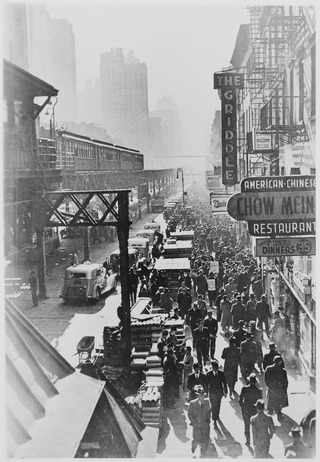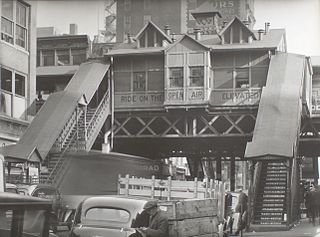Related Research Articles

The Independent Subway System, formerly known as the Independent City-Owned Subway System (ICOSS) or the Independent City-Owned Rapid Transit Railroad (ICORTR), was a rapid transit rail system in New York City that is now part of the New York City Subway. It was first constructed as the Eighth Avenue Line in Manhattan in 1932.

The Spring Street station is a local station on the IRT Lexington Avenue Line of the New York City Subway. Located at the intersection of Lafayette Street and Spring Street in SoHo and Little Italy, Manhattan, it is served by 6 trains at all times, <6> trains during weekdays in the peak direction, and 4 trains during late night hours.

The IRT Sixth Avenue Line, often called the Sixth Avenue Elevated or Sixth Avenue El, was the second elevated railway in Manhattan in New York City, following the Ninth Avenue Elevated.
Bleecker Street is a street in Greenwich Village, New York City.
The Battery Place station was a station on the demolished Ninth Avenue and Sixth Avenue elevated train lines in Manhattan, New York City. It was located at the southern terminus of Greenwich Street at the north end of Battery Park.
The Rector Street station was on the demolished IRT Sixth Avenue Line in Manhattan, New York City. It had three tracks and two side platforms. It opened on June 5, 1878, served by trains from the IRT Sixth Avenue Line, and was one block east of Rector Street El Station on the IRT Ninth Avenue Line. In 1918, Brooklyn Rapid Transit Company built the Broadway Subway through Manhattan and added a station at Rector Street, which served as competition for the 6th Avenue Line station. The el station closed on December 4, 1938. The next southbound stop was Battery Place on the IRT Ninth Avenue Line. The next northbound stop was Cortlandt Street.

The Cortlandt Street station was a station at Church Street on the demolished IRT Sixth Avenue Line in Manhattan, New York City. It had 3 tracks and two side platforms. It was served by trains from the IRT Sixth Avenue Line and opened on June 5, 1878. It closed on December 4, 1938. The next southbound stop was Rector Street. The next northbound stop was Park Place.

The Park Place station was a station on the demolished IRT Sixth Avenue Line in Manhattan, New York City. It had 2 tracks and two side platforms. It was served by trains from the IRT Sixth Avenue Line and opened on June 5, 1878. It closed on December 4, 1938. The next southbound stop was Cortlandt Street for local trains, and Battery Place for express trains. The next northbound stop was Chambers Street for all trains. The Chambers Street – World Trade Center / Park Place station complex can be found within the vicinity of the former elevated railroad station.
The Chambers Street station was a station on the demolished IRT Sixth Avenue Line in Manhattan, New York City. It had two tracks and two side platforms. It was served by trains from the IRT Sixth Avenue Line and opened on June 5, 1878. It closed on December 4, 1938. The next southbound stop was Park Place. The next northbound stop was Franklin Street. The Chambers Street – World Trade Center / Park Place station complex can be found within the vicinity of the former elevated railroad station.
The Grand Street station was a station on the demolished IRT Sixth Avenue Line in Manhattan, New York City. It had two tracks and two side platforms. It was served by trains from the IRT Sixth Avenue Line and opened on June 5, 1878. It closed on December 4, 1938. The next southbound stop was Franklin Street. The next northbound stop was Bleecker Street.

The Eighth Street station was a station on the demolished IRT Sixth Avenue Line in Manhattan, New York City. It had two tracks and two side platforms. It was served by trains from the IRT Sixth Avenue Line and opened on June 5, 1878. It closed on December 4, 1938.

The 14th Street station was a station on the demolished IRT Sixth Avenue Line in Manhattan, New York City. It had two tracks and two side platforms, and was served by trains from the IRT Sixth Avenue Line. The station opened on June 5, 1878, and was designed by famed Hudson River School painter Jasper Francis Cropsey, a trained architect. Beginning in 1907, the station had a connection to the 14th Street subway station of the Hudson and Manhattan Railroad. It closed on December 4, 1938. The next southbound stop was Eighth Street. The next northbound stop was 18th Street. Two years later the station was replaced by the IND Sixth Avenue Line platforms of the 14th Street / Sixth Avenue Subway station complex.

The 23rd Street station was a station on the demolished IRT Sixth Avenue Line in Manhattan, New York City. It had two tracks and two side platforms. It was served by trains from the IRT Sixth Avenue Line. This station opened on June 5, 1878 and closed on December 4, 1938. The next southbound stop was 18th Street. The next northbound stop was 28th Street. Two years later the rapid transit needs of the intersection were replaced by the underground 23rd Street IND subway station.

The 28th Street station was a station on the demolished IRT Sixth Avenue Line in Manhattan, New York City. It had two tracks and two side platforms. It was served by trains from the IRT Sixth Avenue Line. This station opened in 1892. From 1910 to 1937 it also had a connection to the 28th Street. It closed on December 4, 1938. The next southbound stop was 23rd Street. The next northbound stop was 33rd Street.

The 33rd Street station was a station on the demolished IRT Sixth Avenue Line in Manhattan, New York City. It had two tracks and two side platforms. It was served by trains from the IRT Sixth Avenue Line. This station opened on June 5, 1878, and closed on December 4, 1938. The next southbound stop was 28th Street. The next northbound stop was 38th Street. The station was eventually replaced by the 34th Street–Herald Square Subway station complex one block north.

The 42nd Street station was a station on the demolished IRT Sixth Avenue Line in Manhattan, New York City. It had 2 tracks and two side platforms. It was served by trains from the IRT Sixth Avenue Line, and was located near sites such as the New York Public Library headquarters, Bryant Park, and the New York Hippodrome. The station opened on June 5, 1878, and closed on December 4, 1938. The next southbound stop was 38th Street. The next northbound stop was 50th Street. Two years later, the rapid transit needs of the intersection were replaced by the IND Sixth Avenue Line platforms of the 42nd Street–Bryant Park/Fifth Avenue subway station complex.
The 50th Street station was a station on the demolished IRT Sixth Avenue Line in Manhattan, New York City. It had two tracks and two side platforms. It was served by trains from the IRT Sixth Avenue Line and opened on June 5, 1878. It closed on December 4, 1938. The next southbound stop was 42nd Street. For some trains, the next northbound stop was 58th Street Terminal until 1924, while for other trains, the next northbound stop was Eighth Avenue. For express trains, the next northbound stop was 66th Street on Ninth Avenue. Two years later after the station closed, it was replaced by the nearby underground 47th–50th Streets–Rockefeller Center subway station.

The Broadway–Lafayette Street/Bleecker Street station is a New York City Subway station complex in the NoHo neighborhood of Manhattan on the IRT Lexington Avenue Line and the IND Sixth Avenue Line. It is served by the 6, D, and F trains at all times; the B and M trains on weekdays during the day; the <6> and <F> trains during rush hours in the peak direction; and the 4 train during late nights.
References
- 1 2 "Days of Yore Recalled as 'L' Line Goes". Rochester Democrat and Chronicle. December 5, 1938. p. 9. Retrieved June 30, 2019– via Newspapers.com.

- ↑ Superior Court of the City of New York, General Term. 1888. p. 195.